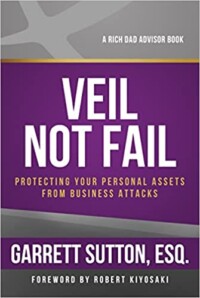Title: Veil Not Fail: Protecting Your Personal Assets from Business Attacks
Author: Garrett Sutton, Esq.
Publisher: BZK Press
ISBN: 978-1947588165
Pages: 192
Genre: Business
Reviewed by: Barbara Bamberger Scott
Pacific Book Review
 If you believe that your corporation or Limited Liability Company is invulnerable to attack, author and corporate expert Garrett Sutton will help you rethink that assumption, grasp some of the legal pitfalls and protect yourself against the possibility of lawsuits that can decimate your business and destroy your dreams of success.
If you believe that your corporation or Limited Liability Company is invulnerable to attack, author and corporate expert Garrett Sutton will help you rethink that assumption, grasp some of the legal pitfalls and protect yourself against the possibility of lawsuits that can decimate your business and destroy your dreams of success.
Converting one’s business into an LLC is generally seen as a strategy to separate one’s personal finances from those of the business, so that in the case of a lawsuit, it would be the company that is liable, and not the owner. Lawsuits arising, such as torts for personal injury or economic demands for unpaid bills, are known as “piercing the veil.” Sutton explains it this way: a veil is filmy, flimsy, and meant to hide a face; piercing it will reveal that face. He suggests that one’s “face” is like the bullseye center of a target and is always visible through the corporate veil. Sutton offers numerous examples of veil piercing, using such lively symbolism as the relation between Clark Kent and his Superman persona, or the machinations behind the scenes by the Wizard of Oz, controlling the “yellow brick” (gold) road.
The case of Ron Resim (all names have been changed, Sutton avows) is a clear-cut example. Resim started an apartment business in a place where the Power Company was restrained by law from forcing customers to pay their bills during brutally cold winters, and set up his corporation, Viewcrest LLC, in one of the apartments which was also his residence. He immediately began ignoring bills from the Power Company, paying accounts months late and rarely in full. The case against him was clear and the judgment harsh. But what if one does not set out to disobey the law? For honest, ambitious business owners, Sutton presents bold guidelines for those who are trying to “do everything right.” These involve ensuring the financial autonomy of each company or subsidiary; intercompany agreements; scrupulous record retention; releasing control of subsidiary companies from the parent company, with clear regulations; and firmly establishing that each entity is in fact legally separate so that one cannot be held responsible for the problems arising in another.
Sutton’s complex, fact-laden and highly informative manual is part of the “Rich Dad” series, for which he has written several guidebooks focused on forming and maintaining one’s business successfully. The rich material offered here will be of interest not only to those directly involved in corporate ownership and management but those considering the rewards, and possible risks, of taking on those roles.


